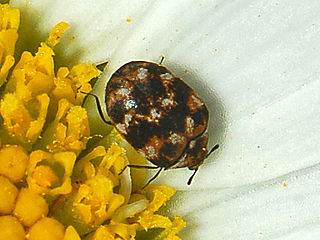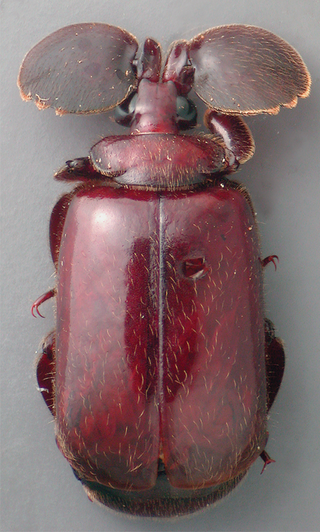
The varied carpet beetle is a 3 mm-long beetle belonging to the family Dermestidae. They are a common species, often considered a pest of domestic houses and, particularly, natural history museums, where the larvae may damage natural fibers and can damage carpets, furniture, clothing, and insect collections. A. verbasci was also the first insect to be shown to have an annual behavioral rhythm and to date remains a classic example of circannual cycles in animals.

Oiceoptoma noveboracense is a member of the family Silphidae, or carrion beetles, which feed on decaying organic matter such as dead animals. Its common name is the margined carrion beetle, from the orange-red margins on the pronotum, which are helpful when identifying this species. The larva is typically light brown to red and also has vertical ridges on its thorax like the adult. This diurnal beetle can be found mainly in the spring into the fall, and it has a strong preference towards a deciduous forest habitat. The primary forensic importance of this beetle is its ability to use the succession of insect fauna to provide confirmation of postmortem intervals.

Alaus oculatus, commonly called the eastern eyed click beetle or eyed elater, is a species of click beetle.

Ambulyx substrigilis, the dark-based gliding hawkmoth, is a species of moth of the family Sphingidae. It was described by John O. Westwood in 1847.

Euchroma giganteum, the Metallic Wood Boring Beetle or Giant Metallic Ceiba Borer, is a species of beetle in the family Buprestidae, the only species in the genus Euchroma.

Archodontes is a genus of root-boring beetles in the family Cerambycidae. It is monotypic, being represented by the single species Archodontes melanopus. It is endemic to Central America and the south-eastern United States, and bores the roots of oaks and other hardwoods.

Episteme adulatrix, the day flying moth, is a species of moth in the genus Episteme of the family Noctuidae.

Tragocephala variegata, the longhorn shoot borer, is a species of flat-faced longhorn beetles belonging to the family Cerambycidae.

Neoclytus longipes is a species of beetle in the family Cerambycidae. It was described by Dru Drury in 1773.
Eburia quadrimaculata is a species of beetle in the family Cerambycidae.

Elaphidion irroratum is a species of beetle in the family Cerambycidae. It was described by Carl Linnaeus in his 1767 12th edition of Systema Naturae.

Steirastoma pustulata is a species of beetle in the family Cerambycidae. It was described by Dru Drury in 1773 from Jamaica.

Chalcophora virginiensis, the sculptured pine borer, is a metallic woodboring beetle of the Buprestidae family. It is endemic to forested areas in the eastern United States and Canada. Some authors have synonymised it with the western species Chalcophora angulicollis, but Maier and Ivie (2013) demonstrate that the species are distinct.

Prosopocera bipunctata is a species of flat-faced longhorn beetles in the subfamily Lamiinae. It was first described by Dru Drury in 1773, from Sierra Leone.

Chilocorus nigritus, sometimes referred to as the Malaysian ladybird beetle, is a species of lady beetle in the family Coccinellidae. It is native to SE Asia, but has been introduced for use in biological pest control in Hawaii and many parts of the world, including Europe.
Adoretus bicaudatus, is a species of shining leaf chafer found in India and Sri Lanka.
Catharsius capucinus, is a species of dung beetle found in India, Sri Lanka, Bangladesh and Nepal.

Onthophagus centricornis, is a species of dung beetle found in Pakistan, Saudi Arabia, Sri Lanka, Vietnam, India, Andaman and Nicobar Islands and Thailand.

Laccophilus inefficiens, is a species of predaceous diving beetle found in India, Bangladesh, Bhutan, Myanmar, Nepal, Pakistan, Sri Lanka, China, Hong Kong, Japan, Taiwan, Vietnam, Laos, Thailand, Indonesia, Iran and Malaysia.

Platyrhopalopsis melleii is a species of ant-nest or flanged bombardier beetle found in southern India. They live inside the nests of ants of the genus Carebara and adults are only rarely seen in the open, most often at night when they get attracted to lights.


















